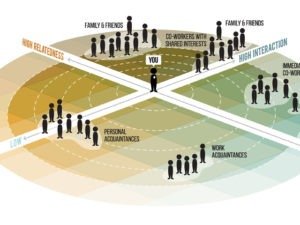Building trust in the workplace is a significant part of improving the employee experience, as a recent global study by Ernst and Young showed less than half of full time workers trust their employer.
Furthermore, according to EY’s study, nearly one in six have “very little” or “no trust” in their current employer. In the United States alone, only 38% of employees who responded to the study said they trusted their employer.
Leaders often have good intentions for the type of environment and culture they want to create within their business and often believe they are achieving their goals. However, to gain an accurate understanding of the level of organizational trust at your company, you must look at trust from the perspective of the employee. If the employee perception doesn’t align with leadership’s intentions, you must look for any disconnects within the layers between leadership and employees.
Trust is built through relationships
In its simplest form, trust is about relationships. Relationships are built on feelings of connectivity and relatedness. When you think about the people you trust the most, they are often family members or close friends. Those relationships are based on frequent interactions and shared interests.
When building trust in the workplace, you have to build relationships based on those same properties. Hierarchies within corporate organizations can make it more challenging to build relationships based on high levels of trust. To successfully build organizational trust, you must choose to forget about titles and levels and focus on employees as individuals.
As with many company culture and engagement initiatives, leaders often want trust to be built quickly. Although leaders may not overtly say, “Let’s make an organizational change. We don’t have trust today, but we’re going to have trust tomorrow,” that’s often the subtext when organizational trust becomes a business priority.
Related: One Thing That Matters For Employee Engagement
In our personal lives, few of us expect to go from a first date to an engagement in a single day, week, or even a month. Relationships based on a significant level of trust don’t happen overnight, there is usually a courting process. It’s important to align your expectations for organizational trust in a similar way. It takes time, effort, and opportunities for interaction to build those relationships. Both parties must be committed to it. If one side is less committed or not committed at all, even if the other one side is fully committed, it’s probably never going to work out. To ensure all parties are committed to the goal of building trust in the workplace, both leaders and employees must understand the benefits of workplace relationships based on trust.
Trust impacts business goals
Human resources professionals should fundamentally understand employees are individuals, they need opportunities to build relationships, and a foundation of trust is critical to the success of the business. Leadership, however, doesn’t always understand this intuitively. When HR practitioners align their engagement goals with the business and financial goals, it becomes difficult for any leader to deny the value of engagement and culture initiatives centered on building trust in the workplace.
If a collaborative organization is one of your business goals, trust is a crucial foundation. When expressing their opinions, employees need to be confident their colleagues won’t degrade their input. Most of us have experienced a group setting where we chose to stay quiet, because we were not confident our opinions would be valued. Conversely, we can also think of times when we felt secure within a group and shared our opinions more freely. The difference between these two scenarios is the foundation of trust. When we feel we can trust the others in the meeting, we are more likely to collaborate fully, thus producing the best possible ideas and solutions for the organization.
Trust can also have a positive effect on organizational performance; it’s the foundation that leads to better productivity for the entire organization. Once employees have built relationships, they don’t view each other as just their titles or their positions, but instead see them as individuals. Once you build trust, you begin to see more workplace engagement. Coworkers are willing to do more for individuals they are connected to, regardless of team or title.
High levels of organizational trust can also have a positive impact on recruiting efforts. Qualified candidates looking to apply for a job often visit review websites, sometimes even before they visit the company’s website. If they see low ratings, it can put a bias against your organization in their mind. That’s not to say the bias can’t be changed during the interview process, but it potentially puts your organization in a lower position than desired, which can result in greater recruiting challenges. On the flip side, if employees are taking time to leave good reviews online, they also likely speak well about the organization to friends and colleagues elsewhere, which can pay big dividends for recruitment.
Three tools for building trust in the workplace
Understanding why organizational trust is important and how it impacts business goals is just the beginning. Once you are ready to make changes to improve the level of trust within your organization, here are three ways to build trust with your coworkers.
Active listening
Active listening is an important part of building trust in the workplace. Truly listening to employee feedback requires discipline. Ask questions, but don’t jump to conclusions. Be fully engaged and listen to all the feedback given without being dismissive. However, you must be careful. If the trust isn’t there, you may only get one opportunity to build trust by listening.
For example, if you ask “How do you feel today?” Your coworker may initially open up and give you an accurate and transparent answer. If you do anything during their response that gives them any reason to doubt your sincerity, you may not receive a honest answer the next time you ask. It’s important to build trust through active listening every time you seek a coworker’s opinion. If they don’t trust you to truly listen when they are telling you about their day, they won’t trust you with their opinions when you ask for feedback about the company.
Transparency
To build trust, you need to be comfortable with being transparent with others, which can be difficult. Being transparent with others, especially at work, may not be something you are naturally comfortable with. It’s often difficult for leaders to be transparent, especially when considering critical business information must sometimes wait for the perfect moment to be revealed. However, if your organization is going to be successfully centered around trust, you must lead by example. Fifty-nine percent of those who responded to the EY study said open, transparent communication is a factor that promotes trust in the workplace.
While leaders may not be able to be transparent about all aspects of the business, you can exhibit trust first by being transparent with some aspects of business, even when it makes you feel vulnerable. If you are in a meeting discussing how to get from point A to point B, you can choose to follow another’s idea, even if it’s not the way you would do it personally. Demonstrating that you trust their opinions to complete the goal is a great way to build organizational trust. Making changes to be more transparent, even in small ways, can be a great way to show to employees you are willing to lead the effort to create an environment of trust.
Authenticity
Corporate leaders can sometimes underestimate how intelligent their employees are. Employees can tell the difference between when leaders are feeding them a line or if they are truly speaking from the heart with sincerity. Sometimes leaders think demonstrating authenticity is a sign of weakness, but that is exactly what employees want.
Letting your guard down is the first key to opening a door to where coworkers start to see your trust in them. One way to begin is by joining the water-cooler talk about weekend plans, families, or what show you are currently binging. Showing your humanity whether you are in the C-suite or a manager allows employees to connect with you on a personal level that builds trust.
Building trust in the workplace takes time and effort. It also requires a personal investment to be transparent and authentic with coworkers, even when it’s uncomfortable. When leaders at every level are equipped with relationship building skills, it can create a foundation of trust felt by all employees.


 5 min
5 min




